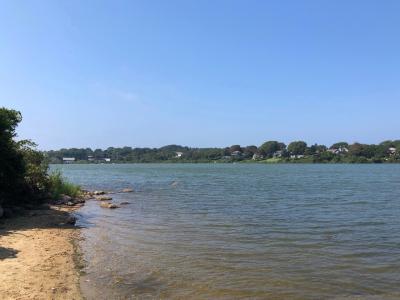Harmful Algal Bloom Detected in Montauk's Fort Pond

A bloom of cyanobacteria, or blue-green algae, has been confirmed in Fort Pond in Montauk. Sampling conducted by Concerned Citizens of Montauk on Wednesday confirmed a bloom in the pond's southern portion. The bloom, composed of the cyanobacteria Aphanizomenon and Anabaena, is being tested today for levels of the toxin microcystin. An alert about the bloom is to be listed on Friday on the State Department of Environmental Conservation's harmful algae bloom notifications page.
Following the finding Wednesday, East Hampton Town officials are to post signs cautioning individuals to keep children and pets away from the bloom area and to avoid contact with the water. In addition, the northern end of the pond shows elevated risk of a bloom, therefore the entire pond should be avoided until the bloom has cleared, according to a statement issued by C.C.O.M.
In May, C.C.O.M. and Dr. Christopher Gobler of Stony Brook University's School of Marine and Atmospheric Sciences announced a new partnership on a harmful algal bloom monitoring program in Fort Pond, following the cyanobacteria blooms that were detected during the summers of 2015 and 2017. Samples were initially collected biweekly. Weekly sampling began in June and is to continue at least through this month. The last four weeks showed elevated risk of a bloom at both the north and south sampling locations.
C.C.O.M.'s funding, sourced through grants and donations, cover the costs of the sampling and transportation to Dr. Gobler's lab; the State Department of Environmental Conservation pays for the samples to be processed.
Outside of Montauk, Dr. Gobler has been monitoring water under jurisdiction of the town trustees for five years, with a particular focus on Georgica Pond in East Hampton, which has experienced toxic blooms of cyanobacteria, or blue-green algae, in each of the last several summers. His lab also analyzes water collected from lakes, ponds, and other water bodies on Long Island and in New York City for the D.E.C.
In addition to Ford Pond, cyanobacteria have bloomed this summer in Georgica Pond, Wainscott Pond, Lake Agawam in Southampton, Mill Pond in Water Mill, Roth Pond in Stony Brook, Laurel Lake in Laurel, Maratooka Lake in Mattituck, and Fresh Pond on Shelter Island.
Though blue-green algae are naturally present in lakes and streams in low numbers, they can become abundant, forming blooms in shades of green, blue-green, yellow, brown, or red. They may produce floating scums on the surface of the water or may cause the water to take on paint-like appearance.
Harmful algal blooms are typically fueled by increased nutrient loadings from septic systems and stormwater runoff. Mitigating direct discharges of stormwater, avoiding the use of fertilizers, and replacing outdated and ineffective cesspools and septic systems with new innovative systems, which utilize nitrogen treatment technologies, can help remedy the problem. Suffolk County and the Town of East Hampton offer financial assistance for septic system replacement.
